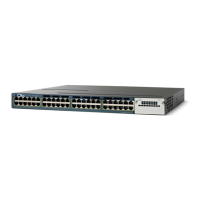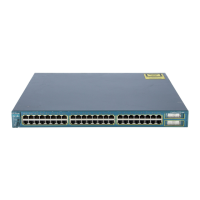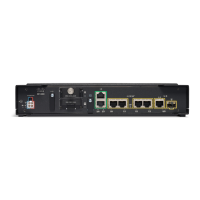1-6
Catalyst 3750-X and 3560-X Switch Software Configuration Guide
OL-25303-03
Chapter 1 Configuring Interface Characteristics
Interface Types
interface for each VLAN for which you want to route traffic, and assign it an IP address. For more
information, see the “Manually Assigning IP Information” section on page 1-15.
Note When you create an SVI, it does not become active until it is associated with a physical port.
SVIs support routing protocols and bridging configurations. For more information about configuring IP
routing, see Chapter 1, “Configuring IP Unicast Routing,” Chapter 1, “Configuring IP Multicast
Routing,”and Chapter 1, “Configuring Fallback Bridging.”
Note The LAN Base feature set supports only static routing on SVIs. The IP Base feature set supports static
routing and RIP. For more advanced routing or for fallback bridging, enable the IP Services feature set
on the standalone switch or the active switch. For information about using the software activation feature
to install a software license for a specific feature set, see the Cisco IOS Software Activation document.
SVI Autostate Exclude
The line state of an SVI with multiple ports on a VLAN is in the up state when it meets these conditions:
• The VLAN exists and is active in the VLAN database on the switch.
• The VLAN interface exists and is not administratively down.
• At least one Layer 2 (access or trunk) port exists, has a link in the up state on this VLAN, and is in
the spanning-tree forwarding state on the VLAN.
Note The protocol link state for VLAN interfaces comes up when the first switch port belonging to the
corresponding VLAN link comes up and is in STP forwarding state.
The default action, when a VLAN has multiple ports, is that the SVI goes down when all ports in the
VLAN go down. You can use the SVI autostate exclude feature to configure a port so that it is not
included in the SVI line-state up-an- down calculation. For example, if the only active port on the VLAN
is a monitoring port, you might configure autostate exclude on that port so that the VLAN goes down
when all other ports go down. When enabled on a port, autostate exclude applies to all VLANs that are
enabled on that port.
The VLAN interface is brought up when one Layer 2 port in the VLAN has had time to converge
(transition from STP listening-learning state to forwarding state). This prevents features such as routing
protocols from using the VLAN interface as if it were fully operational and minimizes other problems,
such as routing black holes. For information about configuring autostate exclude, see the “Configuring
SVI Autostate Exclude” section on page 1-42.
EtherChannel Port Groups
EtherChannel port groups consider multiple switch ports to be one switch port. These port groups act as
a single logical port for high-bandwidth connections between switches or between switches and servers.
An EtherChannel balances the traffic load across the links in the channel. If a link within the
EtherChannel fails, traffic previously carried over the failed link changes to the remaining links. You can
group multiple trunk ports into one logical trunk port, group multiple access ports into one logical access
port, group multiple tunnel ports into one logical tunnel port, or group multiple routed ports into one

